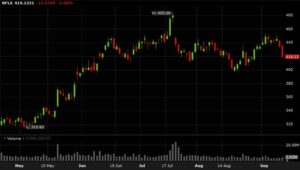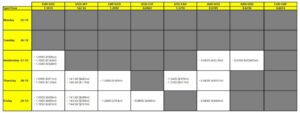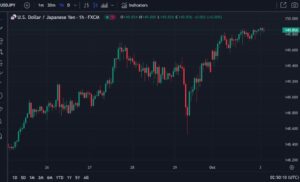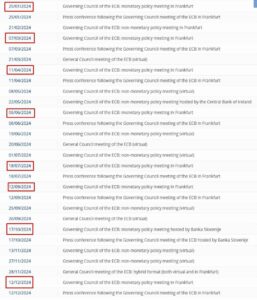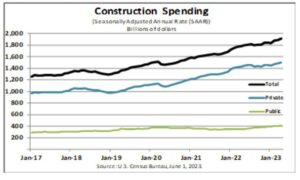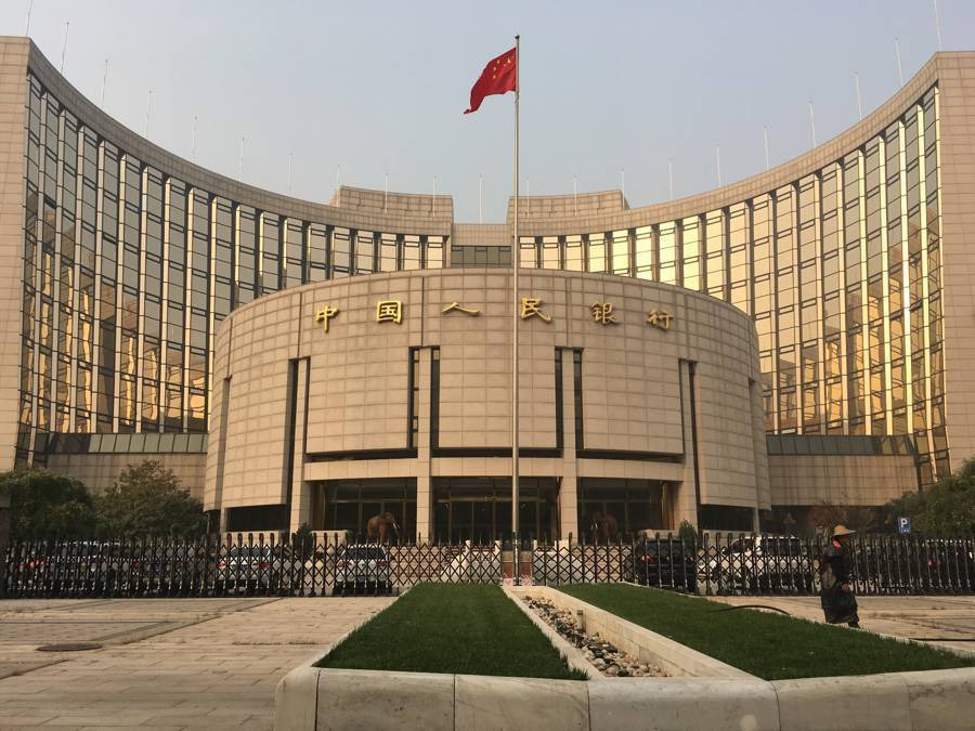
The PBoC left its LPR rates unchanged as expected:
- LPR 1-year 3.45%.
- LPR 5-year 4.20%.
PBoC
ECB’s Wunsch (hawk – voter) gave a clear signal that the ECB is going to hold rates steady in the next two months, but warned that an easing in financial conditions due to rate cuts bets could prompt further rate hikes:
- Bets on rate cuts risk prompting rate hikes instead.
- Markets are optimistic to rule out further rate hikes.
- But rates should stay unchanged in December and January.
ECB's Wunsch
ECB’s de Cos (dove – voter) pushed back against rate cuts bets:
- ECB is not expected return to forward guidance on monetary policy.
- It is absolutely premature to start talking about interest rates cuts.
ECB's de Cos
The US Leading Economic Index (LEI) posted another decline coming in at -0.8% vs. -0.7% expected and -0.7% prior. This is the 19th consecutive monthly decline.
US LEI Index
Fed’s Barkin (neutral – non voter) repeated that the Fed remains data-dependent and resolute to keep conditions tighter for longer given the uncertainty around inflation:
- Not a big time to offering forward guidance.
- Fed will respond to data.
- Overall core inflation numbers are coming down nicely, but a lot of that is for goods.
- Business contacts on the ground report they are still raising prices faster than before pandemic.
- Continue to view inflation as a stubborn which feeds the higher for longer approach.
- Skilled trades continue to see wage pressures.
- Inflation does seem to be settling but the job is not done.
Fed's Barkin
BoE’s Governor Bailey (neutral – voter) reaffirmed the BoE’s “higher for longer” stance given the tightness in the labour market and elevated wage growth:
- Far too early to be thinking about rate cuts.
- Returning inflation to 2% target remains our absolute priority.
- When inflation is high, we take no chances.
- The tragic events in the Middle East have added upside risk to energy prices.
- Labor market remains tight despite softening recently.
- Wage inflation remains elevated.
- We must be alert to any second-round effects of higher food and energy prices.
- The evolution of food prices will matter for wage growth looking ahead.
- The squeeze on real incomes from higher food and energy prices may still be influencing wage demands.
- Inflation data for October released last week were welcome news, it's much too early to declare victory.
- We must watch for further signs of inflation, persistence and that may require interest rates to rise again.
- How long a restrictive stance will be needed will ultimately depend on what incoming data tells us.
- The MPC's latest projections indicate that monetary policy is likely to be restrictive for quite some time yet.
BoE's Governor Bailey
ECB’s Villeroy (neutral – voter) threw forward guidance out of the window and reaffirmed the ECB’s “wait and see” stance:
- Our reliance on forward guidance was excessive, we should be more modest with future guidance.
- We should expect more bond volatility, renewed increases would be another reason not to hike rates.
- We have to discontinue our PEPP reinvestments in due time, and possibly earlier then the end of 2024.
- On our inflation target, I am not fixated on 2% to the nearest decimal place.
- The latest developments in Israel and the oil market shouldn't significantly change downward inflation trend.
- We should and can avoid recession, a soft-landing path is more likely.
- The question quickly shifted from "When will we stop hiking?" to "When will we start cutting?"
- See rates plateauing for at least the next several meetings and the next few quarters.
ECB's Villeroy
RBA’s Governor Bullock remains optimistic on the labour market side but warns against changes in inflation expectations:
- Optimistic that the gains made in employment can be kept.
- Says inflation is a crucial challenge in the next one or two years.
- Says inflation is not only about supply issues, gasoline and rent, that there is still ongoing and underlying demand.
- If inflation expectations adjust higher in response that's a problem.
- We haven't had any productivity growth in Australia for a number of years.
RBA Governor Bullock
The RBA released the Minutes of its November Monetary Policy Meeting, which were more hawkish than expected:
- Considered case for raising rates or holding steady.
- Board saw "credible case" that a rate rise was not needed at this meeting.
- But judged case for hiking was the stronger one given inflation risks had increased.
- Whether further tightening required would depend on data, assessment of risks.
- Saw risk that inflation expectations could increase if rates were not raised.
- Important to prevent even a modest further increase in inflation expectations.
- Growing mindset among businesses that cost increases could be passed on to customers.
- Noted staff forecasts for inflation at meeting assumed one or two more rate rises.
- Board noted cash rate remained below that in many other countries.
- Rising house prices could indicate policy was not especially restrictive.
- Surge in domestic population growth made it harder to judge resilience of economy.
- Inflation and economy were slowing, geopolitical and global outlook uncertain.
- An escalation in tensions in the middle east could be a drag on global growth.
RBA
BoE’s Governor Bailey and other BoE members reaffirmed their commitment to keep monetary policy tight due to inflation persistence:
- Markets are putting too much weight on current data releases.
- Need to be concerned about potential inflation persistence.
- Need to cement commitment to 2% inflation target (Mann).
- More tightness in monetary policy now is important (Mann).
- Speed limit of UK economy is low now (Ramsden).
- We are very clear in distancing ourselves from market expectations (Ramsden).
- Fall in headline inflation is not a good guide on inflation trend (Haskel).
- We are on target to get inflation back to 2%.
- Latest inflation fall is good news, largely expected.
- There are some signs that wage growth is coming off.
- But there is weakening in some parts of the labour market.
- Inefficient labour market is one upside risk to inflation.
- Approach to monetary policy can be characterised as being watchful, responsive.
- Would not rule out having to raise the bank rate further in the future.
BoE
The Canadian CPI fell further on all measures, which is a welcome news for the BoC:
- CPI Y/Y 3.1% vs. 3.2% expected and 3.8% prior.
- CPI M/M 0.1% vs. 0.1% expected and -0.1% prior.
- BoC Core Y/Y 2.7% vs. 2.8% prior.
- BoC Core M/M 0.3% vs. -0.1% prior.
- CPI Median 3.6% vs. 3.6% expected and 3.9% prior (revised from 3.9%).
- CPI Trimmed-Mean 3.5% vs. 3.6% expected and 3.7% prior.
- CPI Common 4.2% vs. 4.3% expected and 4.4% prior.
Canada Core Inflation Measures
ECB’s President Lagarde (neutral – voter) reaffirmed the ECB’s “wait and see “ approach:
- We have made those future decisions conditional on the incoming data meaning that we can act if we see rising risks of missing our inflation target.
- The energy and supply chain shocks which played a substantial role in last year's inflation surge are now unwinding.
- We expect headline inflation to rise again slightly in the coming months.
- Our monetary policy is in a phase where we need to be attentive to the different forces affecting inflation, but always firmly focused on our mandate.
- We will need to remain attentive until we have firm evidence that the conditions are in place for inflation to return sustainably to our goal.
- Given the scale of our policy adjustment, we can now allow some time for them to unfold.
- This is not the time to start declaring victory.
- Our assessment is that strong wage growth mainly reflects catch-up effects related to past inflation, rather than a self-fulfilling dynamic.
- We need to remain focused on bringing inflation back to our target and not rush to premature conclusions based on short-term developments.
ECB's Lagarde
The Fed released the Minutes of its November FOMC Monetary Policy Meeting, which didn’t contain anything new:
All Participants:
- Agreed that monetary policy should remain restrictive until inflation sustainably moves towards the Committee's objective.
- Judged maintaining the federal funds rate at 5¼ to 5½ percent as appropriate.
- Agreed on the necessity of reducing the Federal Reserve’s securities holdings.
- Agreed that every policy decision should be based on incoming information and its implications for the economic outlook and risk balance.
Most Participants:
- Continued to see upside risks to inflation, including potential prolonged imbalances in aggregate demand and supply.
Many Participants:
- Commented on the significant tightening of financial conditions due to higher long-term yields.
- Observed the contribution of term premiums to the rise in longer-term Treasury yields.
- Noted downside risks to economic activity, including larger-than-expected effects of tightening financial and credit conditions.
Several Participants:
- Noted potential cyber risks and the importance of readiness for such threats.
- Commented on the recent decline in the use of the ON RRP facility.
- Emphasized the importance of banks being prepared to use Federal Reserve liquidity facilities.
Some Participants:
- Noted benefits for businesses from improved hiring ability, supply chains, and reduced input costs.
- Reported difficulties for businesses in passing on cost increases to customers.
- Expressed concern over the sustainability of increased labor supply.
- Highlighted challenges for small businesses due to tighter financial and credit conditions.
A Few Participants:
- Noted nominal wages still rising at rates above those consistent with the 2% inflation objective.
- Expressed concern over the recent pace of increases in labor supply.
- Discussed the importance of monitoring Treasury market functioning and hedge fund leverage.
- Observed that the process of balance sheet runoff could continue even after reducing the federal funds rate target range.
Federal Reserve
RBA’s Governor Bullock delivered some hawkish comments as she sees demand still outstripping supply which could prompt a “more substantial” monetary tightening:
- Inflation challenge is increasingly driven by homegrown demand.
- 'More substantial' monetary policy tightening is right response to demand-driven inflation.
- Supply-chain inflation is easing and has a bit further to run.
- Service costs rising strongly as demand outstrips supply.
- RBA liaison with firms indicates domestic cost pressures are proving persistent.
- Will take time to get inflation back to 2-3% target.
- Board seeking to cool demand while keeping employment growing.
RBA's Bullock
The OPEC+ meeting was postponed from the 26th to the 30th of November. Saudi officials have expressed dissatisfaction with the oil production levels of other member countries. The kingdom, which has voluntarily reduced its oil output by an additional 1 million barrels per day since July, is currently engaged in challenging negotiations with other OPEC+ members about their production rates.
The length of the potential delay for the meeting is still unclear, as no final decision has been made yet. This information comes from delegates involved in the talks, who have requested anonymity due to the private nature of the discussions. Crude Oil sold off on the news but erased the losses in the following days.
OPEC
The US Durable Goods Orders missed expectations across the board with negative revisions to the prior figures:
- Durable goods -5.4% vs. -3.1% expected and 4.0% prior (revised from 4.7%).
- Ex transportation 0.0% vs. 0.1% expected and 0.2% prior (revised from 0.5%).
- Ex defense -6.7% vs. 5.0% prior (revised from 5.8%).
- Non-defense capital goods ex air -0.1% vs. 0.1% expected and -0.2% (revised from 0.6%).
US Durable Goods Orders
The US Jobless Claims beat expectations across the board with Continuing Claims falling for the first time in two months. This data set covered the NFP survey week:
- Initial Claims 209K vs. 226K expected and 233K prior (revised from 231K).
- Continuing Claims 1840K vs. 1875K expected and 1865K prior (revised from 1862K).
US Jobless Claims
BoC’s Governor Macklem reaffirmed their “wait and see” approach:
- Canada interest rates may now be restrictive enough.
- Excess demand that made it too easy to raise prices is now gone.
- Reiterates that if high inflation persists, the Bank of Canada is prepared to raise its policy rate further.
- The Canadian economy is approaching balance, we expect it to remain weak for the next few quarters, which means more downward pressure on inflation.
- Inflation in Canada is still too high and progress cutting it is slower than we had hoped.
- Expectations for near-term inflation have been slow to come down and this is a concern.
- Long-term inflation expectations have remained well-anchored.
- The latest CPI number was certainly encouraging.
- Good news for Canadian citizens.
- Right now, is not time to be thinking about cutting rates.
- We do not have to wait until inflation is back to 2% before we cut interest rates, but we do need to wait until it's clear that we are on that path to hitting 2%.
- When it comes to monetary policy, we will be taking it one meeting at a time.
- If inflation keeps coming down, if we see underlying inflationary pressures ease, we probably won't have to raise rates further.
BoC's Macklem
ECB’s Nagel (hawk – voter) reaffirmed that the central bank has reached its terminal rate and from now they will just keep rates steady as long as necessary to get to the 2% target:
- Believes the ECB is close to a level considered as the terminal rate.
- Uncertain if the ECB will implement further rate increases.
- He anticipates that the ECB rates will remain stable for some time.
- There is no concern that the ECB is moving toward a hard landing.
- Acknowledges the existence of some risk factors that could potentially trigger inflation.
- We will get to our 2% inflation target in the end.
- It is too early to talk about rate cuts.
- Rates must stay high to bring inflation back to target.
- Still cannot be sure if we have reached a peak in rates.
- The goal is in sight in terms of inflation, but not yet reached.
- Inflation could still tick up in the coming months.
- Does not see a hard landing for Eurozone economy.
ECB's Nagel
Thursday was the PMIs day with the US on holiday for Thanksgiving Day:
- Australia Manufacturing PMI 47.7 vs. 48.2 prior.
- Australia Services PMI 46.3 vs. 47.9 prior.
- Eurozone Manufacturing PMI 43.8 vs. 43.4 expected and 43.1 prior.
- Eurozone Services PMI 48.2 vs. 48.1 expected and 47.8 prior.
- UK Manufacturing PMI 46.7 vs. 45.0 expected and 44.8 prior.
- UK Services PMI 50.5 vs. 49.5 expected and 49.5 prior.
PMI
The ECB released the Accounts of its October Monetary Policy Meeting:
- All members agreed to maintain interest rates at current levels.
- Members argued in favour of keeping the door open for a possible further rate hike.
- The view was held that all three elements of the reaction function were moving in the right direction.
- ECB should be ready for further rate hikes if necessary.
- It could be expected that, based on the current outlook, inflation return to 2% target by 2025.
- Members agreed to continue applying flexibility in reinvesting redemptions falling due via PEPP.
- Discussion of an early termination of PEPP reinvestments currently seen as premature.
- Most of the impact of past rate hikes had yet to materialise.
- It was generally assumed that the "last mile" of bringing inflation back to target was the most difficult.
ECB
The New Zealand Retail Sales beat expectations:
- Retail Sales Q/Q 0.0% vs. -0.8% expected and -1.8% prior.
- Retail Sales Y/Y -3.4% vs. -3.5% prior.
- Retail Sales excluding Autos Q/Q 1.0% vs. -1.5% expected and -1.6% prior.
New Zealand Retail Sales YoY
The Japanese CPI missed expectations across the board:
- CPI Y/Y 3.3% vs. 3.4% expected and 3.0% prior.
- Core CPI Y/Y 2.9% vs. 3.0% expected and 2.8% prior.
- Core-Core CPI Y/Y 4.0% vs. 4.1% expected and 4.2% prior.
Japan Core-Core CPI YoY
The Japanese Manufacturing PMI missed expectations while the Services PMI ticked higher:
- Manufacturing PMI 48.1 vs. 48.8 expected and 48.7 prior.
- Services PMI 51.7 vs. 51.6 prior.
Japan Manufacturing PMI
BoE’s Pill (neutral – voter) reaffirmed that the central bank is going to hold rates high amid elevated inflation:
- We cannot afford to ease off tight monetary policy.
- UK monetary policy was in a difficult phase amid "stubbornly high" price pressures.
- Had to resist temptation to declare victory on inflation battle as October print remains high.
- There's slower growth in activity and employment.
- Key indicators that BoE are focusing on i.e. services inflation, pay growth remain at "very elevated levels".
- The challenge is to ensure that there is enough persistence in restrictive monetary policy to bring inflation down.
BoE's Pill
ECB’s Holzmann (hawk – voter) pushed back against rate cuts expectations as he still sees high inflationary pressures:
- The chances of another rate hike are no smaller than that of rate cuts.
- We still have high inflation pressures.
- There are differing expectations within the ECB in terms of what can yet happen.
- That is influenced to a point by how high inflation is in each country.
- My suggestion on PEPP would be to reduce reinvestments step by step starting from March.
ECB's Holzmann
ECB’s President Lagarde (neutral – voter) reaffirmed their “wait and see” stance:
- We have already done a lot on rates, can now observe.
- The battle against inflation is not over.
- We are not declaring victory yet.
- We are seeing progress on inflation.
ECB's President Lagarde
ECB’s de Guindos (neutral – voter) highlighted the stagnation in the Eurozone economy:
- Euro area economy is stagnating in 2nd half of 2023.
- Q4 GDP will likely be similar to Q3.
- Risks tilted to the downside.
- Current level of rates held for long enough will likely tame inflation going forward.
ECB's de Guindos
The Canadian Retail Sales beat expectations:
- Retail Sales September 0.6% vs. 0.0% expected and -0.1% prior.
- Retail Sales ex auto 0.2% vs. -0.2% expected and 0.2% prior (revised from 0.1%).
- Retail Sales ex auto and gas -0.3% vs. -0.3% prior.
- October advanced estimate 0.8%.
- Retail Sales Y/Y 2.7% vs. 1.7% prior (revised from 1.6%).
Canada Retail Sales YoY
The S&P Global US PMIs were basically in line with expectations with a slight miss in the Manufacturing PMI and slight beat in the Services PMI:
- Manufacturing PMI 494. Vs. 49.8 expected and 50.0 prior.
- Services PMI 50.8 vs. 50.4 expected and 50.6 prior.
- Composite PMI 50.7 vs. 50.7 prior.
Key line from the report: “As a result of subdued demand and decreasing backlogs, companies reduced their workforce for the first time since June 2020, affecting both service providers and goods producers.”
US Manufacturing PMI
The highlights for next week will be:
- Tuesday: Australian Retail Sales, US Consumer Confidence.
- Wednesday: Australian Monthly CPI, RBNZ Policy Decision, US GPD Q3 2nd Estimate.
- Thursday: Japan Industrial Production and Retail Sales, China PMIs, Switzerland Retail Sales, Eurozone CPI and Unemployment Rate, Canada GDP, US Core PCE, US Jobless Claims.
- Friday: Japan Jobs data, China Caixin Manufacturing PMI, Switzerland GDP, Canadian Labour Market report, Canada Manufacturing PMI, US ISM Manufacturing PMI
That’s all folks. Have a nice weekend!
- SEO Powered Content & PR Distribution. Get Amplified Today.
- PlatoData.Network Vertical Generative Ai. Empower Yourself. Access Here.
- PlatoAiStream. Web3 Intelligence. Knowledge Amplified. Access Here.
- PlatoESG. Carbon, CleanTech, Energy, Environment, Solar, Waste Management. Access Here.
- PlatoHealth. Biotech and Clinical Trials Intelligence. Access Here.
- Source: https://www.forexlive.com/news/weekly-market-recap-20-24-november-20231124/
- :has
- :is
- :not
- :where
- ][p
- $UP
- 1
- 2%
- 2% Inflation
- 2020
- 2024
- 2025
- 26
- 46
- 49
- 50
- 51
- 7
- 8
- 9
- a
- ability
- About
- above
- Absolute
- absolutely
- Accounts
- across
- Act
- activity
- added
- Additional
- adjust
- Adjustment
- advanced
- affecting
- After
- again
- against
- aggregate
- ahead
- AIR
- Alert
- All
- allow
- already
- always
- am
- Amid
- among
- an
- and
- Anonymity
- Another
- anticipates
- any
- anything
- Applying
- approach
- approaching
- appropriate
- ARE
- AREA
- argued
- around
- AS
- assessment
- assumed
- At
- Australia
- auto
- avoid
- back
- BAILeY
- Balance
- Balance Sheet
- Bank
- bank of canada
- Bank Rate
- Banks
- barrels
- based
- Basically
- Battle
- BE
- beat
- been
- before
- being
- below
- benefits
- Bets
- Big
- Bit
- board
- BoC
- BoE
- bond
- both
- bring
- Bringing
- businesses
- but
- by
- CAN
- Canada
- Canada GDP
- Canada Manufacturing PMI
- Canadian
- Canadian Retail Sales
- cannot
- capital
- case
- Cash
- cement
- central
- Central Bank
- certainly
- chain
- chains
- challenge
- challenges
- challenging
- chances
- change
- Changes
- characterised
- China
- China Caixin Manufacturing PMI
- China PMIs
- Citizens
- claims
- clear
- Close
- come
- comes
- coming
- comments
- commitment
- committee
- Common
- Companies
- Concern
- concerned
- conditions
- confidence
- consecutive
- considered
- consistent
- consumer
- contacts
- contain
- continue
- continuing
- contribution
- Cool
- Core
- core inflation
- cos
- Cost
- Costs
- could
- countries
- country
- covered
- CPI
- credible
- credit
- crucial
- crude
- Crude oil
- Current
- Currently
- Customers
- Cut
- cuts
- cutting
- cyber
- data
- data set
- day
- Days
- December
- decision
- decisions
- Decline
- decreasing
- Defense
- delay
- delegates
- delivered
- Demand
- depend
- Despite
- developments
- different
- differing
- difficult
- difficulties
- direction
- discussions
- do
- does
- Domestic
- done
- Door
- dove
- down
- downside
- downward
- driven
- due
- dynamic
- e
- each
- Earlier
- Early
- ease
- easing
- East
- easy
- ECB
- Economic
- economy
- effects
- elements
- elevated
- employment
- encouraging
- end
- energy
- energy prices
- engaged
- enough
- ensure
- escalation
- especially
- estimate
- Ether (ETH)
- Eurozone
- Eurozone CPI
- Even
- events
- Every
- evidence
- evolution
- excessive
- excluding
- expect
- expectations
- expected
- expressed
- facilities
- Facility
- factors
- Fall
- Falling
- faster
- Fed
- Federal
- Federal Funds Rate
- federal reserve
- Federal Reserve’s
- few
- Figures
- final
- financial
- Firm
- firmly
- firms
- First
- first time
- Flexibility
- focused
- focusing
- following
- FOMC
- food
- For
- Forces
- forecasts
- Forward
- from
- function
- functioning
- fund
- funds
- further
- future
- Gains
- GAS
- gasoline
- gave
- GDP
- generally
- geopolitical
- get
- given
- Global
- goal
- going
- gone
- good
- goods
- Governor
- Governor Macklem
- GPD
- Ground
- Growing
- Growth
- guidance
- guide
- had
- Half
- happen
- Hard
- harder
- Have
- haven
- having
- Hawk
- Hawkish
- he
- headline
- hedge
- hedge fund
- Held
- High
- High inflation
- higher
- Highlighted
- highlights
- Hike
- Hikes
- hiking
- Hiring
- hitting
- hold
- holding
- Holdings
- Holiday
- homegrown
- House
- How
- How High
- HTTPS
- i
- if
- Impact
- implement
- implications
- importance
- important
- improved
- in
- Including
- Incoming
- Increase
- increased
- Increases
- increasingly
- index
- indicate
- indicates
- Indicators
- industrial
- Industrial Production
- inflation
- Inflation expectations
- Inflationary
- Inflationary pressures
- influenced
- influencing
- information
- input
- interest
- Interest Rates
- involved
- Israel
- issues
- IT
- ITS
- Japanese
- Job
- jobless claims
- Jobs
- jpg
- judge
- judged
- July
- june
- just
- Keep
- keeping
- kept
- Kingdom
- labor
- Labour
- Lagarde
- landing
- largely
- Last
- last mile
- Last Year
- latest
- leading
- least
- left
- Length
- Level
- levels
- Leverage
- liaison
- likely
- LIMIT
- Line
- Liquidity
- Long
- long-term
- longer
- looking
- losses
- Lot
- Low
- LPR
- Macklem
- made
- mainly
- maintain
- maintaining
- mandate
- manufacturing
- many
- March
- Market
- Market Report
- Matter
- May..
- meaning
- means
- measures
- meeting
- meetings
- member
- Members
- Middle
- Middle East
- million
- Mindset
- minutes
- miss
- missed
- missing
- modest
- Monetary
- Monetary Policy
- monetary tightening
- monitoring
- monthly
- months
- more
- most
- moves
- moving
- MPC
- much
- must
- Nature
- necessary
- necessity
- Need
- needed
- negative
- negotiations
- Neutral
- New
- New Zealand
- news
- next
- next week
- nfp
- nice
- no
- noted
- November
- now
- number
- numbers
- objective
- october
- of
- off
- offering
- officials
- Oil
- on
- ONE
- ongoing
- only
- open
- Optimistic
- or
- orders
- Other
- our
- ourselves
- out
- Outlook
- output
- outstrips
- over
- Pace
- pandemic
- participants
- parts
- passed
- Passing
- past
- path
- Pay
- PBOC
- pce
- Peak
- per
- percent
- persistence
- persists
- phase
- Place
- plato
- Plato Data Intelligence
- PlatoData
- played
- pmi
- Point
- policy
- population
- possible
- possibly
- posted
- potential
- potentially
- Premature
- prepared
- president
- pressure
- prevent
- price
- Prices
- Prior
- priority
- private
- probably
- process
- Producers
- Production
- productivity
- Progress
- projections
- providers
- proving
- pushed
- Putting
- Q3
- question
- quickly
- quite
- raise
- raised
- raising
- range
- Rate
- Rate Hike
- rate hikes
- Rates
- rather
- RBA
- RBNZ
- reached
- reaction
- Readiness
- ready
- reaffirmed
- real
- reason
- recap
- recent
- recently
- recession
- redemptions
- reduce
- Reduced
- reducing
- reflects
- related
- released
- Releases
- reliance
- remain
- remained
- remains
- renewed
- Rent
- repeated
- report
- requested
- require
- required
- Reserve
- reserves
- resilience
- Respond
- response
- responsive
- Restrictive
- result
- retail
- Retail Sales
- return
- revisions
- right
- Rise
- Rises
- rising
- Risk
- risk factors
- risks
- Role
- Rule
- Run
- rush
- s
- S&P
- S&P Global
- sales
- Saudi
- saw
- Scale
- Securities
- see
- seeing
- seeking
- seem
- seen
- sees
- September
- service
- Services
- set
- settling
- several
- she
- sheet
- shifted
- short-term
- should
- side
- Sight
- Signal
- significant
- significantly
- Signs
- similar
- since
- slow
- Slowing
- small
- small businesses
- smaller
- soft-landing
- sold
- some
- Squeeze
- stable
- Staff
- stagnating
- STAGNATION
- stance
- start
- Starting
- stay
- steady
- Step
- Still
- Stop
- strong
- stronger
- strongly
- substantial
- such
- supply
- Supply chains
- sure
- surge
- Survey
- Sustainability
- sustainably
- switzerland
- T
- Take
- taking
- Talk
- talking
- Talks
- Target
- tells
- tensions
- term
- Terminal
- terms
- than
- Thanksgiving
- that
- The
- the Fed
- their
- Them
- then
- There.
- they
- Thinking
- this
- those
- threats
- three
- tick
- tightening
- tighter
- time
- to
- too
- toward
- towards
- trades
- transportation
- treasury
- Treasury yields
- Trend
- trigger
- two
- Uk
- Ultimately
- Uncertain
- Uncertainty
- unclear
- underlying
- unemployment
- unemployment rate
- until
- Upside
- us
- US Core PCE
- US Durable Goods
- US Durable Goods Orders
- US ISM Manufacturing
- US Jobless Claims
- use
- very
- via
- victory
- View
- Volatility
- voluntarily
- Voter
- vs
- wage
- wages
- wait
- Warns
- was
- Watch
- we
- week
- weekly
- weight
- welcome
- were
- What
- when
- which
- while
- WHO
- will
- window
- with
- within
- Won
- Workforce
- would
- year
- years
- yet
- yields
- Zealand
- zephyrnet


